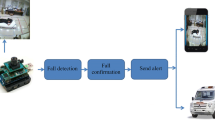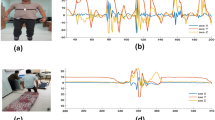Abstract
Recent researches have pointed out that one third persons are aged 65 and above requires special health care. As the number of elderly person is increasing, home monitoring for healthcare applications is playing a vital role in our daily life. Falls are one of the unpredicted but hazardous events. A sudden fall has to be informed to the caretaker immediately and wireless sensor networks are capable of sensing these falls. In this framework, fall frames are identified from a monitored video and transmitted using wireless sensor nodes. Since the multimedia data requires high bandwidth, there is a need for efficient compression. In this paper, compressed sensing based fall detection system for elderly using WSN (CSFDS) is proposed. A quantization with entropy coding is incorporated in this new fall detection framework for achievement of the efficient video compression. Performance evaluation is done using parameters like peak signal to noise ratio, structural similarity index, transmission energy, delay and packet loss. Simulation results show the CSFDS framework outperforming the raw frame transmission by achieving 83.4% reduction in transmission energy and time. An average PSNR and SSIM value of 34.67 dB and 0.9706 respectively is achieved.







Similar content being viewed by others
References
Selvabala, V. S. N., & Ganesh, A. B. (2012). Implementation of wireless sensor network based human fall detection system. Procedia Engineering, 30, 767–773.
Spasova, V., & Iliev, I. (2012). Computer vision and wireless sensor networks in ambient assisted living: State of the art and challenges. Journal of Emerging Trends in Computing and Information Sciences, 3(4), 585–595.
Neggazi, M., Hamami, L., & Amira, A. (2014). Efficient compressive sensing on the shimmer platform for fall detection. In IEEE international symposium on circuits and systems (ISCAS).
Abbate, S., et al. (2010). Monitoring of human movements for fall detection and activities recognition in elderly care using wireless sensor network: a survey. In Wireless sensor networks: Application-centric design. InTech.
Al-Marakeby, A. (2013). Camera-based wireless sensor networks for E-Health. International Journal of Advanced Research in Computer and Communication Engineering, 2, 4757–4761.
Antonio, P., et al. (2013). Fall detection on ambient assisted living using a wireless sensor network. ADCAIJ Advances in Distributed Computing and Artificial Intelligence Journal, 1(1), 62–77.
Suryadevara, N. K., & Mukhopadhyay, S. C. (2014). Determining wellness through an ambient assisted living environment. Intelligent Systems EEE, 29(3), 30–37.
Martin, H. et al. (2009). Analysis of key aspects to manage wireless sensor networks in ambient assisted living environments. In 2nd IEEE international symposium on applied sciences in biomedical and communication technologies, Isabel.
Ye, Y., Ci, S., Katsaggelos, A. K., & Liu, Y. (2013). A multi-camera motion capture system for remote healthcare monitoring. In IEEE international conference on in multimedia and expo (ICME) (pp. 1–6). IEEE.
Jian, H., & Chen, H. (2015). A portable fall detection and alerting system based on k-NN algorithm and remote medicine. Communications China, 12(4), 23–31. (Abbate).
Li, S., Da Xu, L., & Wang, X. (2013). Compressed sensing signal and data acquisition in wireless sensor networks and internet of things. IEEE Transactions on Industrial Informatics, 9(4), 2177–2186.
Luo, X., et al. (2012). Design and implementation of a distributed fall detection system based on wireless sensor networks. EURASIP Journal on Wireless Communications and Networking, 2012(1), 118.
Jung, Y., & Yoon, Y. I. (2017). Multi-level assessment model for wellness service based on human mental stress level. Multimedia Tools and Applications, 76(9), 11305–11317.
Aruna, N., Angayarkanni, V., & Radha, S. (2015). Compressed sensing based quantization with prediction encoding for video transmission in WSN. In IEEE international conference on computation of power, energy information and communication (ICCPEIC).
Cei, T. T., & Wang, L. (2011). Orthogonal Matching pursuit for Sparse Signal Recovery with Noise. In Proceedings of IEEE transactions on information theory (Vol. 57(7)).
Chen, W., & Wassell, I. (2012). Energy-efficient signal acquisition in wireless sensor networks: A compressive sensing framework. IET Wireless Sensor Systems, 2(1), 1–8.
Pinheiro, E. C., Postolache, O. A., & Girao, P. S. (2010). Implementation of compressed sensing in telecardiology sensor networks. International Journal of Telemedicine and Applications. doi:10.1155/2010/127639.
Marcelloni, F., & Vecchio, M. (2009). An efficient lossless compression algorithm for tiny nodes of monitoring wireless sensor networks. Computer Journal, 52(8), 969–987.
Angayarkanni, V., & Radha, S. (2016). Design of bandwidth efficient compressed sensing based prediction measurement encoder for video transmission in wireless sensor networks. Wireless Personal Communications, 88(3), 553–573.
Farizah, Y., et al. (2013). Optimum parameters for MPEG-4 data over wireless sensor network. International Journal of Engineering and Technology, 5(5), 0975–4024.
Nandhini, S. A., et al. (2015). Video compressed sensing framework for wireless multimedia sensor networks using a combination of multiple matrices. Computer and Electrical Engineering. doi:10.1016/j.compeleceng.2015.02.008.
Author information
Authors and Affiliations
Corresponding author
Rights and permissions
About this article
Cite this article
Angayarkanni, V., Akshaya, V. & Radha, S. Design of a Compressive Sensing Based Fall detection System for Elderly Using WSN. Wireless Pers Commun 98, 421–437 (2018). https://doi.org/10.1007/s11277-017-4876-x
Published:
Issue Date:
DOI: https://doi.org/10.1007/s11277-017-4876-x




